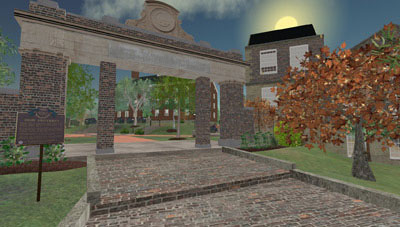Ohio University Opens Virtual Doors
- By Linda L. Briggs
- 02/27/07
Last year, Ohio University purchased two islands and built several buildings on it, including a student center, learning center, and arts and music center. The cost? A few thousands dollars, plus some software development time creating the virtual buildings.
The islands are in Second Life, the popular three-dimensional virtual world created by Linden Labs. In Second Life, which is open to anyone, users create accounts and take on a name and shape, then move through the online world much as in real life. Participants encounter others, hold conversations, buy and sell things, build structures, and in general act as one might in a completely new world, albeit one in which everyone and everything is a computer creation. Sophisticated graphics give the feel of moving across real terrain, with sky, trees, buildings, paths, water, islands, and more.

Ohio University is the first university in Ohio and one of just a few universities in the United States, including Harvard and Princeton, who have launched functioning campuses in Second Life.
Cost and developmentThe university paid Linden Labs $980 per island in setup fees last year and continues to pay $150 a month in fees. (Linden recently increased the island setup fee to $1,675, with a 20 percent discount to educators.) Development time over the six months it took to set up the island added perhaps $30,000 to that cost, according to Christopher Keesey, project manager for marketing and learning applications at Ohio University Without Boundaries, a small group within Ohio University tasked with developing learning experiences for the university and for adult learners.
Access to the island campus is open to anyone who has a Second Life account; with an account, which is free, anyone can visit the Ohio University islands at the following URL:
http://slurl.com/secondlife/ohio%20university/20/36/24/ (might not work with IE). To join Second Life, visit
http://www.secondlife.com/.
Visitors to the campus--which now consists of two connected islands--can take courses and enjoy a host of other features, like exploring parks and buildings and joining real student organizations at the student center. Student groups can meet and collaborate just as they might on campus. An artist in residence has created an installation in the virtual arts and music center, for example, allowing student visitors to meet artists and listen to live music.

Plans for developmentThe university plans to use the campus for distance learning, Keesey says, as well as on campus learning and support. For example, a course kiosk on the Second Life campus currently supports an on campus management course.
Keesey and his team are currently setting up areas on the Second Life campus for various groups at Ohio University. “For any student group who might be in the real-life student center here on campus,” he says, “we’re meeting with them and gathering information.” Supporting materials for the groups on the virtual campus might include videos and podcasts, along with rooms and spaces for students to schedule meetings and impromptu study sessions, view videos, and more.

Although its high-end graphics and the sometimes bizarre names and appearances of participants can create the feeling of a game, those behind the development of the virtual campus don’t think of Second Life that way: It’s “a next-generation learning development environment,” Keesey says. “It’s far more than a game. It’s an all-inclusive environment. You can develop games within it.”
About the Author
Linda Briggs is a freelance writer based in San Diego, Calif. She can be reached at [email protected].